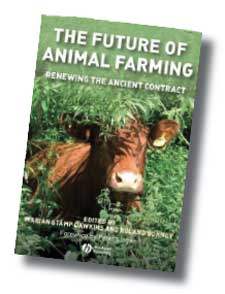Renewing the ancient contract in animal farming

“The future of animal farming: Renewing the ancient contract in animal farming”, was a book written for the general public. Animal producers, including those in the poultry industry, are also very much concerned with its content.
By Dr. Peter Hunton, Cambridge, ON, Canada
The book, published by Blackwell, 2008, has been edited by two well-known British authors, both active in the scientific and practical fields of animal welfare. Marian Stamp Dawkins is a Professor in the Department of Zoology at Somerville College, University of Oxford, and Roland Bonney is one of the founders of the Food Animal Initiative, a private commercial venture that seeks new ways to farm animals in Witham, near Oxford, UK.
“Renewing the ancient contract” refers to the symbiotic relationship that early farmers and their animals enjoyed. Animals were fed, cared for and protected from predators. In return they provided power, milk, eggs and eventually, meat. The attitude of their caretakers was to provide husbandry, implying a great deal of respect and treatment of the animals as individuals. As animal production has been intensified, this attitude has gradually been replaced by a management function, and the practice of husbandry largely replaced by the use of scientific methods.
In the most outspoken and far-reaching chapters, the entire agriculture industry is called to account responsibility for a large contribution to carbon emissions, the irresponsible use of land resources, and outright cruelty to animals are among the charges leveled. Furthermore, the general concepts of carbon emissions, global warming and animal welfare are combined into a generalised critique of animal agriculture, and no rational alternative proposed that might allow continued production of the current volume of animal products. While others have suggested (notably Dr. John Hodges, at the 2008 World’s Poultry Congress in Sydney, Australia) that a re-evaluation of methods and principles is in order, nobody has gone quite so far as some of the authors in this book.
Poultry not excluded
The breeding industry comes in for criticism, too. Fast growing broilers and turkeys, high producing layers, etc., have special requirements, and by their very nature, securing their welfare has become more difficult. Breeders can respond that they obeyed market demand, and indeed, some varieties with reduced performance and greater hardiness are currently available.
There are also voices of moderation. Some of the successes achieved by animal welfare advocates are described. In general, these result from small steps taken over time, leading to gradual changes in management that can be absorbed by the industry while still permitting food to be produced and sold for a profit. For poultry, this refers to reducing stocking density, and the move to free-range and other methods of producing eggs.
Many of the critics of contemporary methods rely on “consumer opinions” for their future demands. How these opinions are captured is sometimes a mystery. One author writes that consumers may be poorly aware of production methods and prefer to remain that way, so they accept that others (retailers, media and other “opinion formers”) make the decisions and agree to go along with them. Nowhere is the opinion accepted that there may be nothing wrong with the production methods and consumers enjoy the economic pricing of their food. The poultry industries have made great strides in improving bird welfare over the past 2-3 decades. Huge moves (such as the elimination of conventional cages in the EU, and the possible elimination of all cages in California) disrupt the supply of products, raise prices and may have minimal real impact on bird welfare.
While we may disagree with some of this book’s content, it is imperative that those involved in the poultry industry read it and understand the implications. Ignoring it could be the ultimate mistake!













